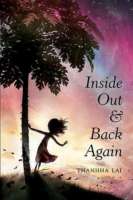
Inside Out and Back Again
Written by Thanhha Lai
HarperCollins, 2011, 272 pp.
ISBN: 978-0061962783
It is 1975 and the war between North and South Vietnam continues. Ha, her mother and her three brothers are celebrating Tet, the Vietnamese new year, and praying for the return of their father who has been missing in action for nine years. Life is becoming challenging as the war moves closer to their home. Ten-year-old Ha, however, is more concerned with her blossoming papaya tree and her upcoming birthday than she is with the increasing prices of food and fuel. With their lives in danger, the family escapes on a cramped navy ship just before the fall of Saigon, and end up in a refugee camp on Guam. Accepted as immigrants to the United Sates, the family is sponsored by a used car salesman in Alabama who needs a mechanic and is impressed with the engineering background of Ha’s oldest brother Quang. So begins Ha’s journey and adjustment to American life. Her strong sense of self and place that was rooted in Vietnam is juxtaposed with her new and disorienting life in Alabama.
Based on the author’s own experiences (although she was actually part of a family of 10), Thanhha Lai brilliantly takes the reader through the tough adjustment of learning English and adapting to American teenage life. For anyone who has ever been thrust into another culture as an adolescent, Lai’s descriptions ring true as they relate Ha’s teasing by classmates, bewilderment over customs that don’t make sense, and struggles to communicate in another language. Right from the start, when classmates think Ha is laughing instead of saying her name, the story evokes a range of emotions familiar to immigrants especially that of feeling twisted inside out while struggling to discover one’s identity in a new place and in a new language.
The pacing of this novel in verse draws the reader into the story. The taut narrative reflects the lyricism and pictorial nature of Vietnamese poetry. Embedded in Ha’s reflections are her longing for Saigon, its people, foods, culture, and natural beauty, which challenges the view that all immigrants are happy to be in the U.S. and don’t long for their home country. The strength of this novel is the brilliant use of space, fonts, and punctuation that give a sense of the disorientation Ha feels during her first year in the U.S. Lai poetically transcribes Ha’s efforts to pronounce the difficult sounds in English (MiSSSisss WaSSington) and her puzzlement over grammatical rules that do not make sense to her: “Brother Quang says / add a s to nouns / to mean more than one / even if there’s / already an s / sitting there. / Glass/Glass-es / All day / I practice / squeezing hisses / thorough my teeth. / Whoever invented / English / must have loved / snakes” (p. 118). Her strong family ties help her negotiate new territory even as her mother and brothers struggle to create their own new identities and sense of self. While the story is serious, it is also humorous, reflecting the hilarity of Lai’s real-life family. Whether it’s becoming a Baptist in order to fit into the neighborhood or learning martial arts to avoid bullies, Ha and her family are creative in figuring out how to carve a niche for themselves in their new home.
Inside Out and Back Again is an important addition to the body of literature dealing with immigration. As more and more immigrant children end up in American classrooms, this book can play an important role in helping teachers understand what some of their new students are experiencing as they learn English. Also, as noted immigration scholar Suarez-Orozco (2008) points out in Learning a New Land, meaningful positive relationships are important in the academic adaptation to school in another country. Missus Washington, Ha’s tutor, could be looked at as a role model for caring professionals who seek to welcome immigrant children into their classrooms.
Books that would pair well with Inside Out and Back Again include My Name is Sangoel (Karen Lynn Williams, 2009) that addresses the issue of names. It would also pair well with books describing the difficulty of the immigrant experience, such as La Linea (Ann Jaramillo, 2006), The Arrival (Shaun Tan, 2007), and The Lotus Seed (Sherry Garland, 1997).
Suárez-Orozco, C., Suárez-Orozco, M. & Todorova, I. (2008) Learning a new land: Immigrant students in American society. Cambridge, MA: Belknap Press.
Susan Corapi, University of Arizona
WOW Review, Volume IV, Issue 3 by Worlds of Words is licensed under a Creative Commons Attribution-NonCommercial-ShareAlike 4.0 International License. Based on work at https://wowlit.org/on-line-publications/review/iv-3/

Deborah,
I appreciate that you bring your knowledge and experiences in Haiti to bear as you commented on the language Nick Lake uses and the accuracy of the historical figures he references.
I started the book after hearing Lake speak at ALA Midwinter in January – but the story was just too dark for me at the time. Perhaps, after reading your review, I will pick it up again.
Thank you for your insights.